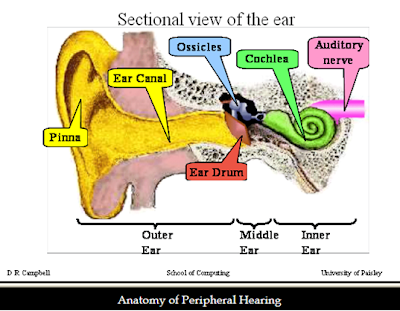The human ear's auditory system can detect rapid changes in sound intensity (dB) and frequency (Hz). We hear this as loudness and pitch.
The auditory system converts changes in air pressure to neural activity, sending signals that allow the brain to attach meaning to the sounds that we hear.
The auditory system converts changes in air pressure to neural activity, sending signals that allow the brain to attach meaning to the sounds that we hear.
There are different parts to the ear; the outer ear, the middle ear and the inner ear. Each are responsible for different, specific functions in hearing.
OUTER EAR
Soundwaves are first collected here, in the outer ear, by the Pinna(outer ear) which is shaped in order to amplify sound and figure out sound location. This leads into the ear canal which leads to the eardrum.
MIDDLE EAR
The soundwaves vibrate your eardrum, this in turn causes the Malleus, Incus and Stapes (3small bones) to vibrate. The Stapes then vibrates a small membrane at the base of the Cochlea.
Soundwaves are first collected here, in the outer ear, by the Pinna(outer ear) which is shaped in order to amplify sound and figure out sound location. This leads into the ear canal which leads to the eardrum.
MIDDLE EAR
The soundwaves vibrate your eardrum, this in turn causes the Malleus, Incus and Stapes (3small bones) to vibrate. The Stapes then vibrates a small membrane at the base of the Cochlea.
INNER EAR
It is here in the inner ear where the complex structures convert sound into neural activity so that your brain can process it.
It is here in the inner ear where the complex structures convert sound into neural activity so that your brain can process it.
If you were to 'unroll' the Cochlear and look inside you would see the Basilar membrane. The Basilar membrane vibrates in response to the sound transmitted to the fluid-filled Cochlea by deflections in the middle ear.
High Frequency sounds displace the stiff base.
Mid Frequency sounds displace the middle of the Basilar membrane.
Low Frequency sounds displace the Apex.
Mid Frequency sounds displace the middle of the Basilar membrane.
Low Frequency sounds displace the Apex.






No comments:
Post a Comment